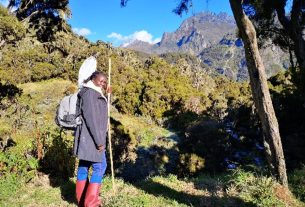Luiz Rezende and Martín Pareja, Universidade Estadual de Campinas (UNICAMP) in Brazil, discuss their article: Foliar herbivory pushes plant individuals towards the periphery of a plant-floral visitor interaction network
Ecological interactions have fascinated naturalists for centuries. Watching bees and butterflies visit flowers continues to mesmerise and nurture a love of nature in children and adults alike. Herbivores that remove leaf tissue has not only fascinated naturalists, but they have also been a major concern for farmers and gardeners throughout history. In the closing paragraph of On the Origin of Species, Charles Darwin reflects on observing a “tangled bank” where organisms interact through laws that act all around us. But what are those laws and do they somehow bind different interactions such as pollination and herbivory? Does the damage caused by herbivores affect the attractiveness of a plant to different pollinators, and does this change how an individual plant interacts with other individuals in the same interaction network? These are the questions we set out to answer examining the tropical shrub Trichogoniopsis adenantha (Asteraceae) in the Atlantic Forest of Brazil. Our results provide fascinating insights into how different interactions are interconnected in natural communities.
How do pollinators respond to herbivory?
Herbivory triggers a cascade of changes in plant traits, from flower density to chemical composition, which in turn impacts interactions with pollinators. We show that plants that suffered higher herbivory produced fewer flowerheads. This, in turn, affected different groups of pollinators in distinct ways. Bees were particularly influenced by flowerhead density and display, and they visited plants with lower herbivory and therefore more flowerheads, more frequently. However, butterflies, moths, and flies were less affected by flowerhead density, with flies showing negative direct responses to leaf damage, possibly due to disruptive plant volatiles. This variability underscores how studying local community composition and pollinator preferences is crucial for understanding how herbivory shapes pollinator interactions.

How does herbivory impact the position of individual plants in a plant-pollinator network?
Possibly the most important result we report is that the position of individual plants within plant-pollinator networks is influenced by herbivory. Plants with more flowerheads occupy central roles in these networks, establishing more interactions with pollinators and serving as key nodes for spreading indirect effects. Since leaf herbivory diminished T. adenantha flowerhead density, highly damaged plants were pushed towards the periphery of the network. Therefore, herbivory can reduce how much influence an individual plant has in transmitting effects through the plant-pollinator network.

Context matters
It is well known that the density of neighboring plants has the potential to significantly change the impact of herbivory. We also investigated this possibility as a source of context dependency in the indirect effects of herbivory on plant-pollinator interactions discussed above. We found that plants in patches with higher conspecific density had lower leaf herbivory, which indirectly increased flowerhead density and hence pollinator visits. By affecting herbivory, and therefore flowerhead density, conspecific density indirectly affected the position of each plant individual in the plant-pollinator network, and therefore its potential to mediate indirect effects. This associational resistance shows that local plant community composition can have important effects in mediating herbivory and its cascading effects throughout plant-pollinator interaction networks.
Looking ahead
The findings from our study highlight the intricate ways herbivory shapes plant-pollinator interactions and network dynamics. By linking mechanisms at the individual plant level to broader community structure, we uncovered how indirect effects propagate through communities. Future research should explore how variability in herbivory across different systems influences these dynamics, offering deeper insights into the cascading ecological consequences of plant-herbivore interactions.
In summary, herbivory is a powerful driver of ecological relationships, influencing not only pairwise interactions but also the structural and functional dynamics of entire pollination networks. As future research deepens into these complex webs of indirect effects, it will allow us to slowly unveil the processes responsible for producing Darwin’s tangled bank.
